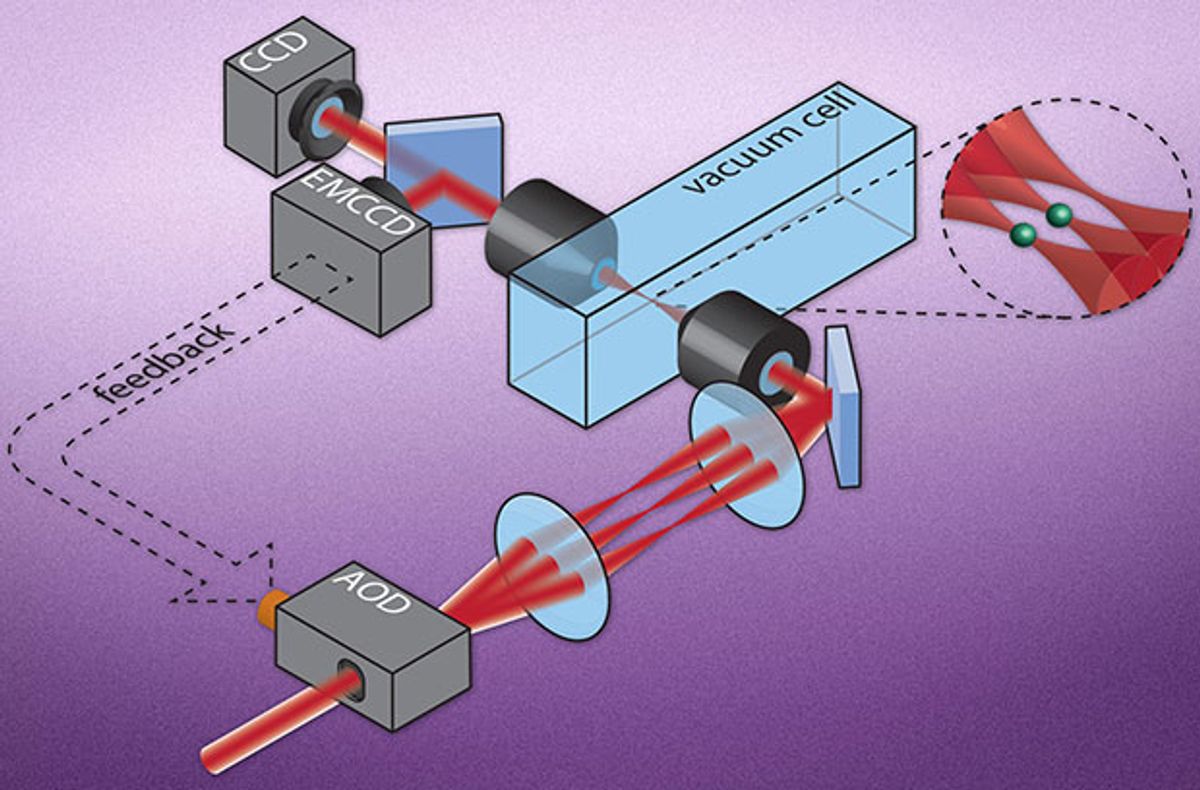Digital logic depends on bits. The binary states of “0” or “1” form the basis of computing. In quantum computers, the bit is replaced by something called a quantum bit (or, qubit), which is an atomic particle that can be coerced into being both 0 and 1 simultaneously, at least for a time.
But one of the problems for quantum computing has been how to get restless atomic particles, like electrons, to sit down together in large groups long enough so that they can be used to carry out calculations.
Researchers at MIT and Harvard University have devised a way to capture atomic particles using optical “tweezers” and hold them in place long enough to take a picture of them so that their locations can be determined and lasers can be directed at them based on that information. Optical tweezers—more formally known as “single-beam gradient force traps”—have been a key instrument in manipulating matter in biology and quantum optic applications since Bell Labs first described that instrument in 1986.
In research published in the journal Science, the Harvard and MIT researchers were able to use these optical tweezers to create large arrays of atoms arranged into defect-free patterns.
“We have demonstrated a reconfigurable array of traps for single atoms, where we can prepare up to 50 individual atoms in separate traps deterministically, for future use in quantum information processing, quantum simulations, or precision measurements,” said Vladan Vuletic, a member of MIT’s Research Laboratory of Electronics and co-author of the research, in a press release. “It’s like Legos of atoms that you build up, and you can decide where you want each block to be.”
One of the critical features of the atoms that the researchers were able to arrange was that they were neutral atoms, which means tht they had no electrical charge. This is a big departure from most qubit particles, which have been built around charged atoms, or ions. The charge of the atoms makes them far easier to trap.
But neutral atoms offer another big advantage: They can be placed in close proximity to each other. Still, they are extremely difficult to hold in place because they are very susceptible to weak forces.
“The trick is to trap them, and in particular, to trap many of them,” said Vuletic. “People have been able to trap many neutral atoms, but not in a way that you could form a regular structure with them. And for quantum computing, you need to be able to move specific atoms to specific locations, with individual control.”
So, what is the better atom trap the researchers created? It all starts with a laser that is used to cool a cloud of rubidium atoms to near absolute zero temperatures, which slows them down. Then, another laser beam is passed through a splitter that creates many beams. The number of beams and their angles are determined by a radio frequency that is applied to the deflector.
When the smaller beams were aimed at the ultracold atoms, a single atom was attracted to the point in a beam where the intensity was the highest. This is how single atoms were picked out and held in place.
“It’s similar to charging up a comb by rubbing it against something woolen, and using it to pick up small pieces of paper,” explained Vuletic. “It’s a similar process with atoms, which are attracted to regions of high intensity of the light field.”
Once the atoms are trapped in this way, they begin to emit light, making it possible for a charged-coupled-device (CCD) camera to capture an image of it. From the images, the researchers were able to determine which of the laser beams had successfully captured an atom and which were empty. The researchers were able to essentially switch off those beams that did not have an atom by selecting certain radio frequencies. In those beams’ place, they put the ones with atoms, yielding a defect-free array of atoms. In this way, the researchers achieved a maximum of 50 atoms that were held in place for a few seconds.
A few seconds may not sound like very long, but a neutral atom can perform 100,000 quantum operations in a second. The researchers believe that this lifetime of a few seconds is adequate for quantum computing.
The main issue that they intend to address is creating quantum gates with the neutral atoms. It has been previously demonstrated that charged atoms under certain conditions can be made to perform quantum gates, which are logic operations that occur between two quantum bits that are similar to logic gates in regular computer circuits. However, this ability has never before been achieved with neutral atoms. If the researchers can pull it off, it could be a significant step toward realizing quantum computing.
Dexter Johnson is a contributing editor at IEEE Spectrum, with a focus on nanotechnology.



